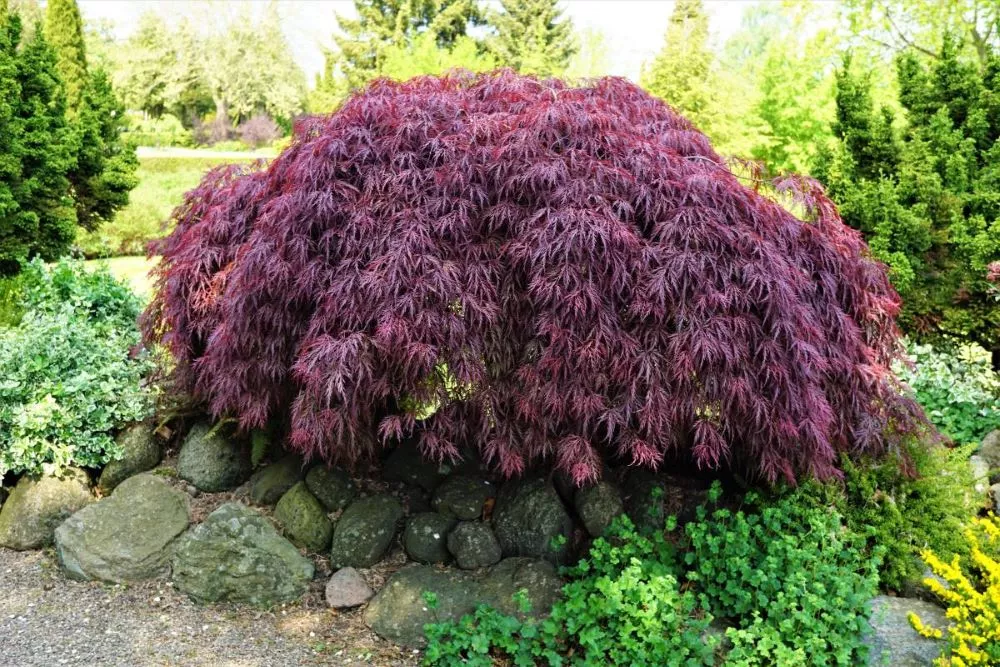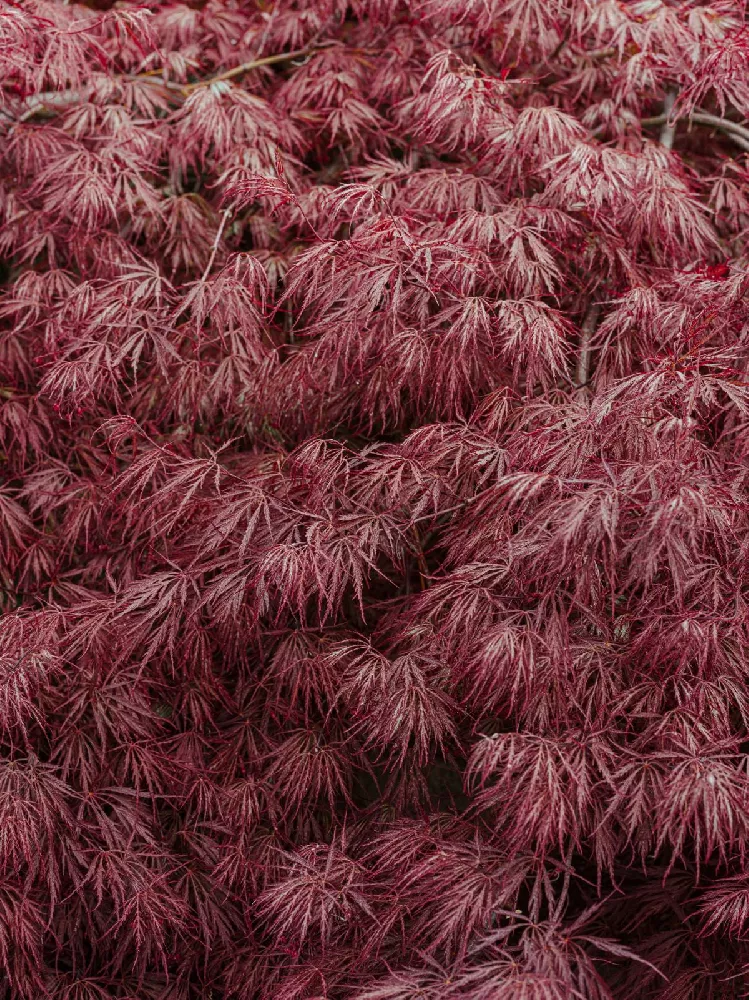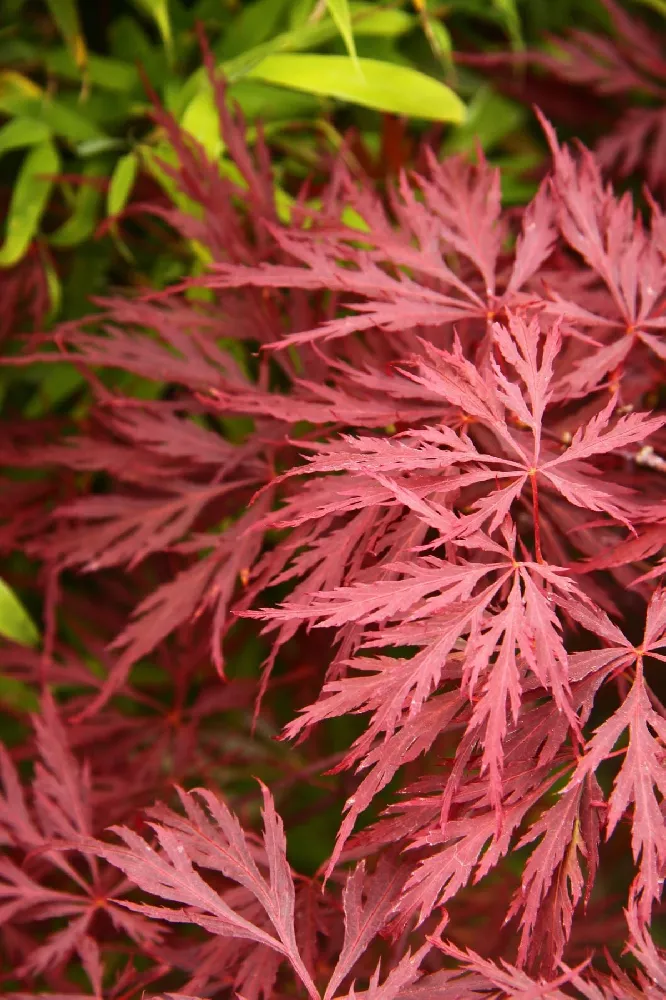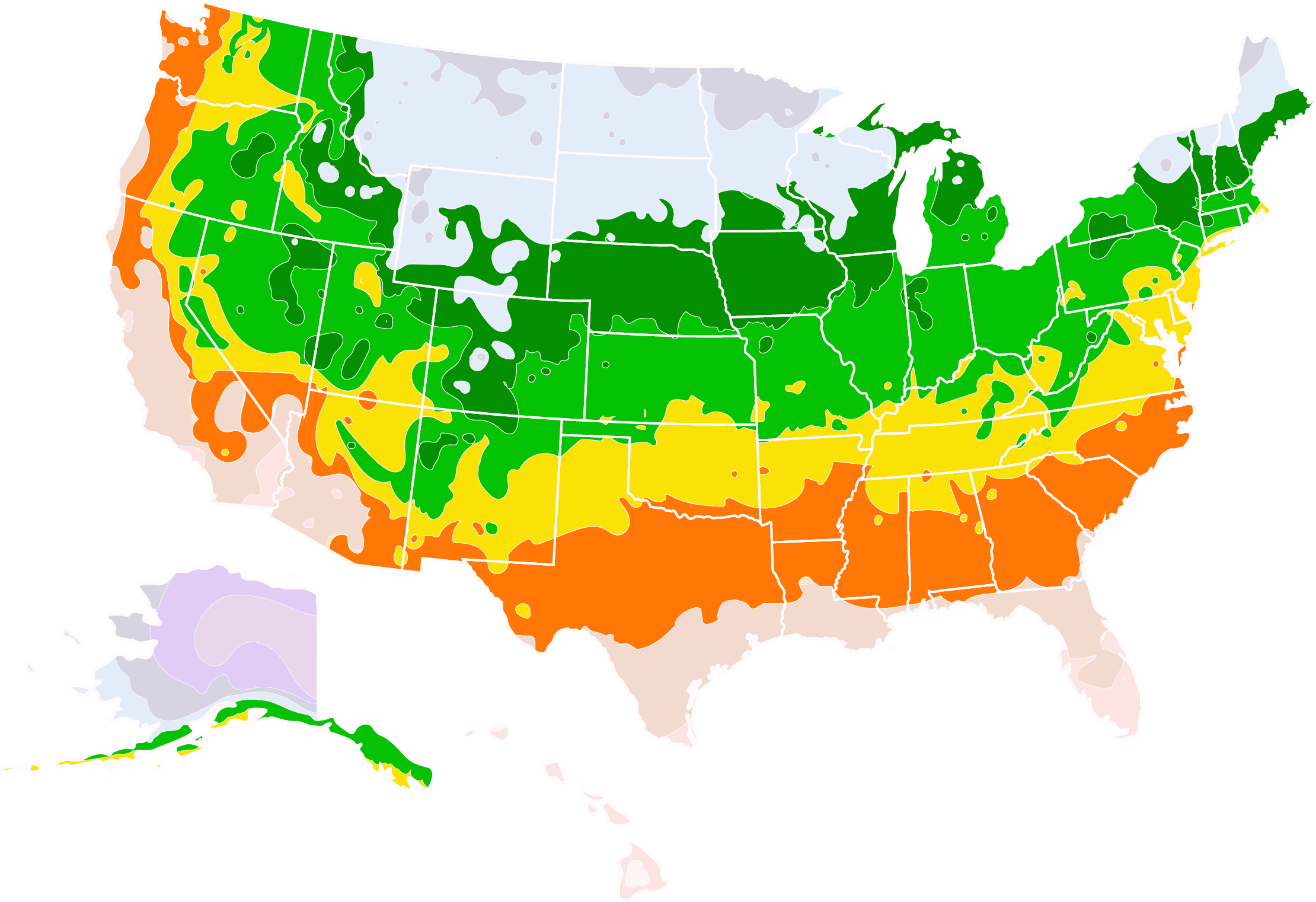- Home >
- Maple Trees >
- Tamukeyama Japanese Maple
Tamukeyama Japanese Maple for Sale - Buying & Growing Guide
Acer palmatum 'Tamukeyama,' also known as the Tamukeyama Japanese Maple Tree, is a Japanese maple cultivar with exceptional aesthetic appeal. The deciduous leaves of this plant have a thin, thread-like texture, a deep purple hue in spring and fall and a bright scarlet color in fall. The Tamukeyama Japanese Maple Tree also stands out due to its growth habit. It grows just a few feet tall with long weeping branches that form a rounded mass of beautiful foliage.
- The foliage is deep purple in spring and summer and scarlet in fall.
- This plant has a weeping form that creates a unique dome-like shape.
- The care routine for this plant is easy to follow.
Enter your zip code to find nearby stores that may carry this plant.
Plant Care
Sunlight

Tamukeyama Japanese Maple Trees can grow well in full sunlight and partial shade.
Watering
Water every few days for newly planted trees. Water once per week during the growing season after that.
Fertilizing

Use a low-nitrogen fertilizer once per year in the early spring.
Planting and Care
Planting instructions
The Tamukeyama Japanese Maple is not too picky about how much sunlight it receives. It will survive in both full sunlight and partial shade conditions. Regarding soil quality, this cultivar will perform best where the soil is relatively moist but well-draining, rich with organic nutrients and slightly acidic. When you find a growing location that meets those requirements, you should dig a hole that is as deep as the root ball is tall and at least twice as wide. Place your plant in the hole, backfill with nutrient-rich soil and cover the area with a layer of organic mulch.
Watering and nutrients
After planting your Tamukeyama Japanese Maple Tree, you should water it about once every two to three days during the first growing season. After the first growing season or two, you can reduce your watering schedule to about once every week while increasing that rate to about twice per week when needed—based on the weather and soil dryness. You should fertilize your Tamukeyama Japanese Maple Tree once per year during the early spring using a fertilizer that is low in nitrogen.
Pollination
The flowers of a Tamukeyama Japanese Maple are small and inconspicuous, meaning that they hold little to no ornamental value. However, they do play an important functional role in this plant’s reproductive process. In spring, those flowers attract pollinating insects that carry pollen from one flower to another. Since the Tamukeyama Japanese Maple is a self-fertile tree, it is quite easy for it to carry out pollination successfully each year. Following pollination, the tree will produce a set of fruit in the form of winged samaras.
Pruning
The pruning needs for the Tamukeyama Japanese Maple Tree are low. Generally, most people allow this plant to develop its natural weeping form without the need for corrective pruning. In fact, pruning too much can cause this plant to produce too much new growth, which will often become weak and detract from the plant’s overall structure. You can prune in the summer or during the winter dormancy period. In either case, you should keep your pruning light and remove just the parts of the plant that are dead, damaged or show signs of disease.
Pests and diseases
Japanese maples typically face threats from several common pests and diseases. These can include canker, leaf spots and wilt, along with infections, including root rot. Along with those complications, a Japanese maple can also experience chlorosis when the soil pH gets too high. However, while that is the case for most standard Japanese maples, the cultivated variety known as “Tamukeyama Japanese Maple” shows comparatively higher pest and disease resistance, which means you likely won’t run into too many issues while you care for this plant.
Achieving maximum results
As long as you choose a suitable growing location and maintain a consistent watering schedule, your Tamukeyama Japanese Maple should remain healthy. At times, these plants can perform a bit better when they live where there is some afternoon shade, but this is not a requirement for healthy growth. Also, if you notice that your plant’s foliage color is not as deep as you expected, it is not likely a sign of disease. Instead, different light conditions can make for subtle variations in the appearance of this plant’s leaves.
FAQs
How large does a Tamukeyama Japanese Maple grow?
The Tamukeyama Japanese Maple Tree is a smaller version of a standard Japanese maple. It grows to be just about six to eight feet tall. However, the spread of this plant can be a bit larger. The mature width of a Tamukeyama Japanese Maple can reach up to ten to 12 feet wide. Still, this plant is relatively small overall, which makes it a welcomed guest in most gardens as it is unlikely to outcompete other plants.
What is the origin of the Tamukeyama Japanese Maple?
As the name suggests, the Tamukeyama Japanese Maple comes from Japan. However, it is not a native tree variety. Instead, it is a cultivated variety of the Acer palmatum species. The Tamukeyama Japanese Maple was popular in Japan for many years before it gained an introduction to Europe in the 1700s. Currently, the Tamukeyama Japanese Maple is one of the oldest cultivated versions of the Japanese maple still in use today.
Is the Tamukeyama Japanese Maple deer resistant?
Along with having great pest and disease resistance and being quite easy to care for, the Tamukeyama Japanese Maple Tree also shows an admirable resistance to deer browsing. While other plants in your garden, including other types of Japanese maple, may commonly experience a loss of leaves due to deer, you won't need to worry about this problem with the Tamukeyama Japanese Maple in most cases.
You can't add more Product Name - Product size to the cart.
OK



